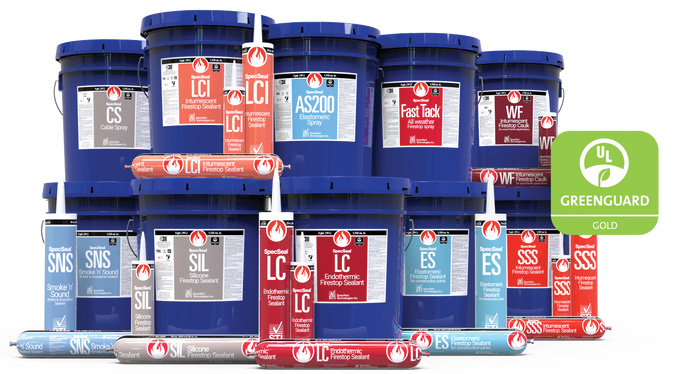
Photo courtesy of Specified Technologies Inc.
Firestop systems play a critical role in maintaining the integrity of a building’s passive fire protection strategy, yet they are often underappreciated or misapplied in design specifications.
Firestop systems play a critical role in maintaining the integrity of a building’s passive fire protection strategy, yet they are often underappreciated or misapplied in design specifications. For architects, understanding the importance of specifying firestop correctly is essential to ensuring life safety, code compliance, and the overall resilience of the building. Missteps in firestop specification can compromise compartmentation strategies, increase liability risks, and result in costly remediation during construction or later in the building’s life cycle.
One of the most common mistakes is the use of generic or boilerplate specifications that fail to address project-specific conditions or assemblies. This can lead to the selection of incorrect systems or misapplication in the field. Additionally, while widely used spec-writing tools offer efficiency, they often lack the detail and specificity required for complex firestop assemblies, leaving gaps that can undermine a project’s fire safety objectives.
Today, architects have access to a range of resources and tools designed to make the firestop specification process more accurate, efficient, and defensible. Leveraging manufacturer support services, UL system databases, and third-party resources can streamline the process while reducing errors and liability. This article will explore the process of firestop system specification with an emphasis on how a well-crafted specification ensures that the design intent is carried through to installation and inspection.
UNDERSTANDING FIRESTOP SYSTEMS
While often confused or used interchangeably in conversation, firestop systems and fireproofing serve distinct purposes within a building’s overall fire protection strategy. Fireproofing refers primarily to the application of insulating materials—such as spray-applied fire-resistive materials (SFRM) or intumescent coatings—directly onto structural elements like steel beams, columns, or decks. The goal of fireproofing is to protect these critical load-bearing components from extreme heat exposure during a fire, allowing them to maintain structural integrity and preventing premature collapse. Fireproofing is a passive fire protection measure focused on preserving the stability of the building itself, buying valuable time for occupants to evacuate and for emergency personnel to intervene.
Firestop systems, on the other hand, are designed to maintain the fire-resistance rating of walls, floors, and ceilings by sealing penetrations, joints, and gaps created by building services such as electrical conduits, pipes, ducts, or cable trays. Unlike fireproofing, which protects structural members, firestopping is focused on compartmentation—containing fire, smoke, and toxic gases to their point of origin by ensuring the continuity of rated assemblies. Firestop systems are critical to preserving the compartmentation strategy of the building, enabling safe evacuation routes, protecting property, and slowing the spread of fire, smoke, and toxins released when materials burn. Both systems are essential, but they address different threats and perform different roles in the overall defense against fire.
A comprehensive understanding of firestopping begins with recognizing its role within the broader category of life safety building systems required by code. Systems such as sprinklers, fire alarms, dampers, and spray-applied fireproofing are all mandated by building codes to enhance occupant safety and protect the structure during a fire event. These systems work collectively to mitigate fire risks; however, each is installed by separate trades at different phases of construction. This fragmented installation approach introduces vulnerabilities, particularly when it comes to firestopping, which, despite its critical role, is often overlooked or misunderstood in the construction process.
Currently, the construction industry lacks a designated, universally recognized trade responsible for firestop installation. Unlike plumbing, electrical, or mechanical systems, there is no legal mandate or union requirement assigning firestop duties to a specific discipline. This has created a problematic culture where firestopping is frequently treated as an afterthought, relegated to the least experienced crew members, often with little training or oversight. The result is widespread misapplication, the use of incorrect products, and inconsistent installation practices that undermine the intended performance of firestop systems.
Any time a penetration is made through a fire-resistance-rated assembly—whether for an outlet box, ductwork, cable tray, piping, or conduit—that assembly’s integrity is compromised. To restore its performance, appropriate firestop systems must be specified and correctly installed. This includes sealing all penetrations, joints, and gaps to maintain the continuity of the fire barrier. In the case of construction joints, such as head-of-wall, floor-to-wall, or wall-to-wall conditions, firestopping ensures that the junctions between assemblies function as a unified, continuous protective envelope.
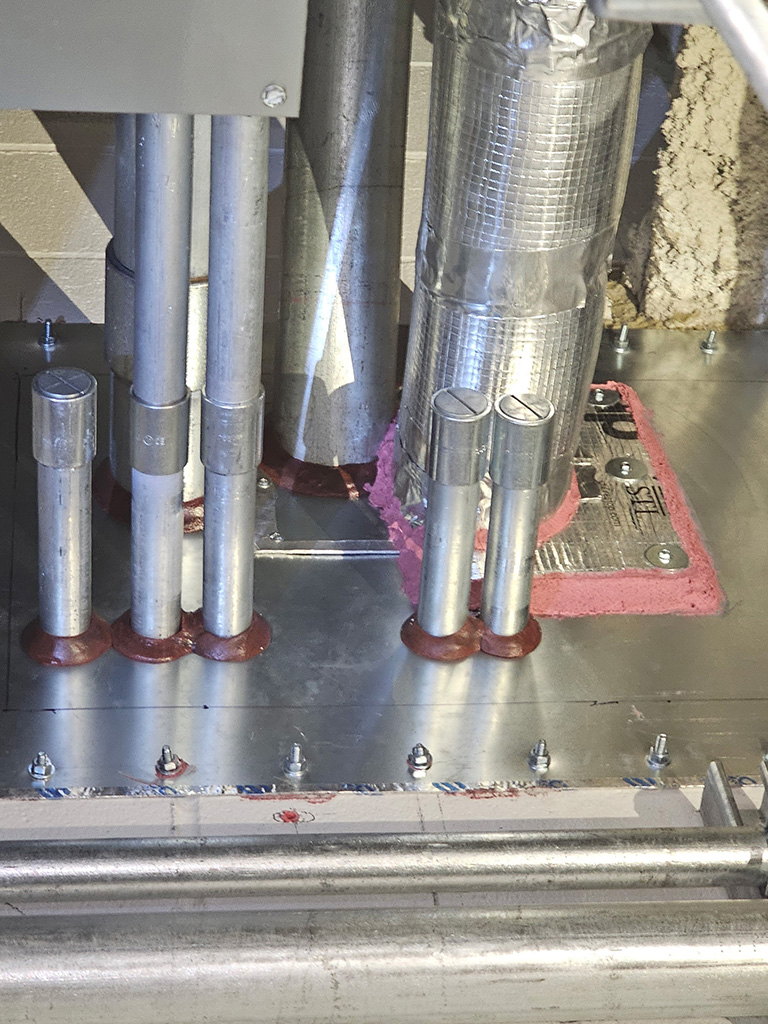
Photo courtesy of Specified Technologies Inc.
Any time a penetration is made through a fire-resistance-rated assembly, that assembly’s integrity is compromised. To restore its performance, appropriate firestop systems must be specified and correctly installed. This includes sealing all penetrations, joints, and gaps to maintain the continuity of the fire barrier.
Despite best intentions to install or restore an effective firestop system, common errors include using hard-setting sealants around low-voltage cable penetrations, where future access or modifications are almost certain, leading to unnecessary complications or code violations. In other cases, products that are sensitive to moisture may be used in high-humidity environments, compromising their effectiveness and longevity. These errors are not always the result of intentional negligence but are often due to a lack of understanding or awareness of firestopping requirements among trades.
Firestopping is a complicated yet critical aspect of construction that calls for careful planning to include room for technological advances. “As buildings become more complex, it’s critical that firestop systems evolve to be smarter, easier to install, and fully integrated with digital tools,” says John Zalepka, Director of Training & Industry Engagements at Specified Technologies Inc. “At STI, we’re not just developing products—we’re empowering the industry through training and technology to ensure firestopping is done right the first time.”
Ultimately, the primary purpose of firestopping is to protect life safety. By restoring the rated performance of assemblies, firestop systems help contain fire, smoke, and toxic gases within designated compartments, providing building occupants with critical additional time to evacuate safely. Despite its technical nature, firestopping is, at its core, about ensuring that people have the best possible chance of surviving a fire event.
KEY PRINCIPLES OF FIRE PROTECTION
To fully understand the role of firestopping in modern building design, it is important to first place it within the broader framework of fire protection strategies. Building fire safety is not reliant on a single system but is instead based on a layered approach known as the three key principles of fire protection: early detection, active suppression, and passive fire protection. Each layer serves a distinct purpose, working together to minimize risk, protect occupants, and support the efforts of emergency responders.
Early Detection: The first line of defense in any fire protection plan is early detection. This involves the use of smoke and heat detectors, fire alarms, and emergency egress lighting. These systems are designed to quickly alert occupants and building management to the presence of fire or smoke, allowing for rapid evacuation and activation of emergency protocols. Early detection systems do not prevent fires from starting, nor do they control the spread of fire directly, but their timely operation is critical to providing occupants with the information they need to exit the building safely.
Active Suppression: Following detection, active suppression systems work to directly combat the fire itself. This is the aspect of fire protection that most people are familiar with, encompassing sprinkler systems, standpipes, fire extinguishers, and manual firefighting efforts. Active suppression works by applying water, foam, or chemical agents to slow or extinguish flames, buying valuable time for first responders to arrive and safely manage the situation. While these systems are critical to minimizing property damage and loss of life, they do not address the containment of fire or smoke within the building’s structural elements.
Passive Fire Protection and Containment: Often, the most overlooked—yet equally critical—layer of fire protection is passive fire protection, or containment. This is where firestopping plays a central role. Unlike active systems that require activation or manual intervention, passive fire protection works continuously, using the building’s construction itself to prevent the spread of fire, smoke, and toxic gases beyond their point of origin.
Passive fire protection strategies rely on the use of fire-resistance-rated walls, floors, doors, and glazing systems to create compartments within a building, also known as “defend-in-place” strategies. By dividing a structure into smaller, isolated areas, fire and smoke are restricted to a defined zone, reducing the speed and extent of spread. This not only improves the safety of occupants by increasing the availability of escape routes but also supports safer conditions for first responders entering the building during an emergency.
The effectiveness of this compartmentation approach hinges on maintaining the integrity of these barriers, even as they are penetrated for mechanical, electrical, plumbing, and communication systems. Firestopping is the method by which these penetrations and joints are sealed, restoring the hourly fire-resistance rating of the assembly. This ensures that barriers perform as intended under fire conditions.
Additionally, compartmentation supports “defend-in-place” strategies for certain building types where evacuation is difficult or impossible. Hospitals, assisted living facilities, correctional institutions, and other occupancy types may rely on passive fire protection to maintain safe zones during a fire event, providing critical protection for occupants until rescue can occur.

Image courtesy of Specified Technologies Inc.
The spread of fire can be restricted by dividing a building into separate compartments with fire-rated walls and fire-rated floors, increasing the availability of escape routes for occupants.
WHAT ARE FIRESTOP PRODUCTS?
Firestop products are a critical component of a balanced fire and life safety plan. These products are specially formulated, independently tested materials designed to seal penetrations and joints in fire-resistance-rated walls, floors, and ceilings, preventing the spread of fire, smoke, and toxic gases. Ideally, these products are specifically engineered and produced to maintain the integrity of fire-resistive barriers, but as with all building materials, not all are equally manufactured to the highest quality standards and expectations. Because of the critical necessity of these products and systems, it is important to have a working knowledge of how to evaluate them prior to specification.
Examples of firestop applications are numerous and varied. At the head-of-wall joint, where a gypsum wall meets a composite floor with a metal deck, an elastomeric spray is commonly applied to maintain the assembly’s rating. For data cable penetrations, specific fire-rated pathway devices and systems are available for off-the-shelf purchase that provide a maintenance-free solution that preserves fire and smoke seals while allowing for cable changes over time. Firestop pillows can be used in larger penetrations like cable ladders, providing a flexible, removable firestop solution. More commonly, intumescent sealants are applied around penetrations made by metal pipes or conduits, expanding when exposed to heat to close gaps and maintain the fire-resistance rating of the assembly.
Remember, the goal is to utilize firestop systems that support the building’s overall compartmentation strategy, ensuring that fire and its byproducts are contained at their source.
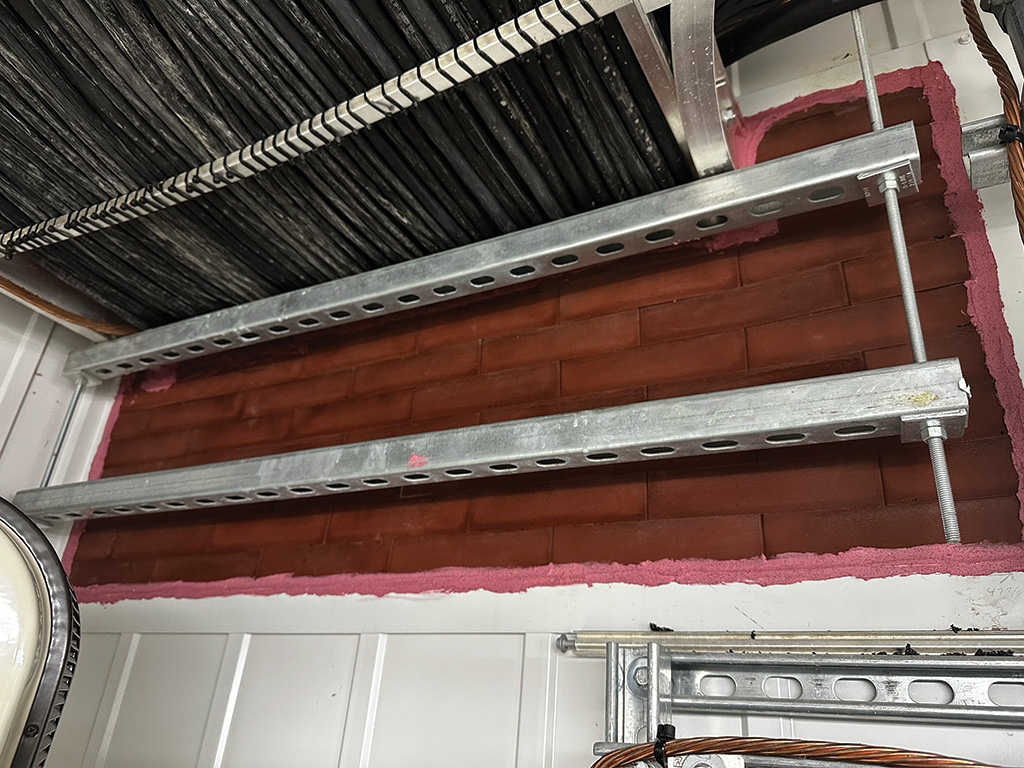
Photo courtesy of Specified Technologies Inc.
For data cable penetrations, specific fire-rated pathway devices and systems are available for off-the-shelf purchase that provide a maintenance-free solution that preserves fire and smoke seals while allowing for cable changes over time.
Rating Firestop Products
When specifying firestop systems, understanding their performance ratings is essential to selecting the right product for each application. Firestop systems are evaluated through rigorous testing to ensure they not only block flames but also address heat transfer, air leakage, and water resistance. Familiarity with the F, T, L, and W ratings helps make informed decisions that support both code compliance and the long-term safety, health, and durability of the building. By recognizing what each rating measures, design professionals can ensure that the selected firestop system meets the specific needs of the assembly and the overall fire and life safety plan.
F Ratings: The cornerstone of all firestop product performance is the F rating, which measures the system’s ability to prevent the passage of flames through the protected opening during a fire test. This rating is expressed in hourly increments, typically 1, 2, 3, or 4 hours, and represents the duration the firestop system maintained its integrity during standardized fire exposure. To earn an F rating, firestop systems are evaluated in accordance with ASTM E814 or UL 1479.
T Ratings: In addition to flame resistance, the T rating measures the system’s ability to limit heat transfer through the assembly. Specifically, it gauges the time it takes for the non-fire side of a penetrated assembly to experience a temperature rise of 325°F above ambient conditions. This is critical in preventing fires that can be ignited by radiant heat alone. For example, if a metal pipe penetrates a floor near combustible materials like paper or cleaning supplies, the pipe may become hot enough during a fire to ignite these items, even if the flames never breach the barrier. Thermocouples are used during UL 1479 testing to monitor temperature rise, ensuring that the assembly limits heat transfer effectively.
L Ratings: Beyond fire and heat, many firestop systems also carry an L rating, which measures the amount of air leakage—simulating smoke movement—through a firestop system at both ambient and elevated temperatures (400°F). This is critical in smoke management, particularly in smoke barriers. According to the International Building Code (IBC) Section 714.4.4, penetrations in smoke barriers must be tested for air leakage using UL 1479. The L rating for these systems must not exceed 5 cubic feet per minute (cfm) per square foot of opening area, or a total of 50 cfm for any 100 square feet of wall or floor area. These standards ensure that even when not exposed to fire, firestop systems help limit smoke migration throughout the building.
W Ratings: The W rating is a more recent addition to firestop system testing, addressing concerns about water resistance. Building owners increasingly require firestop systems that can resist water penetration, particularly in floor assemblies where leaks or “washout” can occur during construction. Washout refers to the scenario where water from construction activities, rain, or mechanical system failure washes away uncured or improperly applied firestop materials, compromising the seal’s integrity. To earn a W rating, the system must withstand a 3-foot head of water for 72 hours without leaking. This rating ensures that firestop systems maintain their performance even in wet conditions, providing added peace of mind for both contractors and building owners.
Ultimately, the correct application of firestop systems—and a clear understanding of their ratings—helps validate that fire-resistive assemblies perform as intended throughout the life of the building. By selecting systems that address flame, heat, smoke, and water risks, architects can enhance the building’s overall integrity.

Photo courtesy of Specified Technologies Inc.
Firestop systems play a critical role in maintaining the integrity of a building’s passive fire protection strategy, yet they are often underappreciated or misapplied in design specifications.
Firestop systems play a critical role in maintaining the integrity of a building’s passive fire protection strategy, yet they are often underappreciated or misapplied in design specifications. For architects, understanding the importance of specifying firestop correctly is essential to ensuring life safety, code compliance, and the overall resilience of the building. Missteps in firestop specification can compromise compartmentation strategies, increase liability risks, and result in costly remediation during construction or later in the building’s life cycle.
One of the most common mistakes is the use of generic or boilerplate specifications that fail to address project-specific conditions or assemblies. This can lead to the selection of incorrect systems or misapplication in the field. Additionally, while widely used spec-writing tools offer efficiency, they often lack the detail and specificity required for complex firestop assemblies, leaving gaps that can undermine a project’s fire safety objectives.
Today, architects have access to a range of resources and tools designed to make the firestop specification process more accurate, efficient, and defensible. Leveraging manufacturer support services, UL system databases, and third-party resources can streamline the process while reducing errors and liability. This article will explore the process of firestop system specification with an emphasis on how a well-crafted specification ensures that the design intent is carried through to installation and inspection.
UNDERSTANDING FIRESTOP SYSTEMS
While often confused or used interchangeably in conversation, firestop systems and fireproofing serve distinct purposes within a building’s overall fire protection strategy. Fireproofing refers primarily to the application of insulating materials—such as spray-applied fire-resistive materials (SFRM) or intumescent coatings—directly onto structural elements like steel beams, columns, or decks. The goal of fireproofing is to protect these critical load-bearing components from extreme heat exposure during a fire, allowing them to maintain structural integrity and preventing premature collapse. Fireproofing is a passive fire protection measure focused on preserving the stability of the building itself, buying valuable time for occupants to evacuate and for emergency personnel to intervene.
Firestop systems, on the other hand, are designed to maintain the fire-resistance rating of walls, floors, and ceilings by sealing penetrations, joints, and gaps created by building services such as electrical conduits, pipes, ducts, or cable trays. Unlike fireproofing, which protects structural members, firestopping is focused on compartmentation—containing fire, smoke, and toxic gases to their point of origin by ensuring the continuity of rated assemblies. Firestop systems are critical to preserving the compartmentation strategy of the building, enabling safe evacuation routes, protecting property, and slowing the spread of fire, smoke, and toxins released when materials burn. Both systems are essential, but they address different threats and perform different roles in the overall defense against fire.
A comprehensive understanding of firestopping begins with recognizing its role within the broader category of life safety building systems required by code. Systems such as sprinklers, fire alarms, dampers, and spray-applied fireproofing are all mandated by building codes to enhance occupant safety and protect the structure during a fire event. These systems work collectively to mitigate fire risks; however, each is installed by separate trades at different phases of construction. This fragmented installation approach introduces vulnerabilities, particularly when it comes to firestopping, which, despite its critical role, is often overlooked or misunderstood in the construction process.
Currently, the construction industry lacks a designated, universally recognized trade responsible for firestop installation. Unlike plumbing, electrical, or mechanical systems, there is no legal mandate or union requirement assigning firestop duties to a specific discipline. This has created a problematic culture where firestopping is frequently treated as an afterthought, relegated to the least experienced crew members, often with little training or oversight. The result is widespread misapplication, the use of incorrect products, and inconsistent installation practices that undermine the intended performance of firestop systems.
Any time a penetration is made through a fire-resistance-rated assembly—whether for an outlet box, ductwork, cable tray, piping, or conduit—that assembly’s integrity is compromised. To restore its performance, appropriate firestop systems must be specified and correctly installed. This includes sealing all penetrations, joints, and gaps to maintain the continuity of the fire barrier. In the case of construction joints, such as head-of-wall, floor-to-wall, or wall-to-wall conditions, firestopping ensures that the junctions between assemblies function as a unified, continuous protective envelope.

Photo courtesy of Specified Technologies Inc.
Any time a penetration is made through a fire-resistance-rated assembly, that assembly’s integrity is compromised. To restore its performance, appropriate firestop systems must be specified and correctly installed. This includes sealing all penetrations, joints, and gaps to maintain the continuity of the fire barrier.
Despite best intentions to install or restore an effective firestop system, common errors include using hard-setting sealants around low-voltage cable penetrations, where future access or modifications are almost certain, leading to unnecessary complications or code violations. In other cases, products that are sensitive to moisture may be used in high-humidity environments, compromising their effectiveness and longevity. These errors are not always the result of intentional negligence but are often due to a lack of understanding or awareness of firestopping requirements among trades.
Firestopping is a complicated yet critical aspect of construction that calls for careful planning to include room for technological advances. “As buildings become more complex, it’s critical that firestop systems evolve to be smarter, easier to install, and fully integrated with digital tools,” says John Zalepka, Director of Training & Industry Engagements at Specified Technologies Inc. “At STI, we’re not just developing products—we’re empowering the industry through training and technology to ensure firestopping is done right the first time.”
Ultimately, the primary purpose of firestopping is to protect life safety. By restoring the rated performance of assemblies, firestop systems help contain fire, smoke, and toxic gases within designated compartments, providing building occupants with critical additional time to evacuate safely. Despite its technical nature, firestopping is, at its core, about ensuring that people have the best possible chance of surviving a fire event.
KEY PRINCIPLES OF FIRE PROTECTION
To fully understand the role of firestopping in modern building design, it is important to first place it within the broader framework of fire protection strategies. Building fire safety is not reliant on a single system but is instead based on a layered approach known as the three key principles of fire protection: early detection, active suppression, and passive fire protection. Each layer serves a distinct purpose, working together to minimize risk, protect occupants, and support the efforts of emergency responders.
Early Detection: The first line of defense in any fire protection plan is early detection. This involves the use of smoke and heat detectors, fire alarms, and emergency egress lighting. These systems are designed to quickly alert occupants and building management to the presence of fire or smoke, allowing for rapid evacuation and activation of emergency protocols. Early detection systems do not prevent fires from starting, nor do they control the spread of fire directly, but their timely operation is critical to providing occupants with the information they need to exit the building safely.
Active Suppression: Following detection, active suppression systems work to directly combat the fire itself. This is the aspect of fire protection that most people are familiar with, encompassing sprinkler systems, standpipes, fire extinguishers, and manual firefighting efforts. Active suppression works by applying water, foam, or chemical agents to slow or extinguish flames, buying valuable time for first responders to arrive and safely manage the situation. While these systems are critical to minimizing property damage and loss of life, they do not address the containment of fire or smoke within the building’s structural elements.
Passive Fire Protection and Containment: Often, the most overlooked—yet equally critical—layer of fire protection is passive fire protection, or containment. This is where firestopping plays a central role. Unlike active systems that require activation or manual intervention, passive fire protection works continuously, using the building’s construction itself to prevent the spread of fire, smoke, and toxic gases beyond their point of origin.
Passive fire protection strategies rely on the use of fire-resistance-rated walls, floors, doors, and glazing systems to create compartments within a building, also known as “defend-in-place” strategies. By dividing a structure into smaller, isolated areas, fire and smoke are restricted to a defined zone, reducing the speed and extent of spread. This not only improves the safety of occupants by increasing the availability of escape routes but also supports safer conditions for first responders entering the building during an emergency.
The effectiveness of this compartmentation approach hinges on maintaining the integrity of these barriers, even as they are penetrated for mechanical, electrical, plumbing, and communication systems. Firestopping is the method by which these penetrations and joints are sealed, restoring the hourly fire-resistance rating of the assembly. This ensures that barriers perform as intended under fire conditions.
Additionally, compartmentation supports “defend-in-place” strategies for certain building types where evacuation is difficult or impossible. Hospitals, assisted living facilities, correctional institutions, and other occupancy types may rely on passive fire protection to maintain safe zones during a fire event, providing critical protection for occupants until rescue can occur.

Image courtesy of Specified Technologies Inc.
The spread of fire can be restricted by dividing a building into separate compartments with fire-rated walls and fire-rated floors, increasing the availability of escape routes for occupants.
WHAT ARE FIRESTOP PRODUCTS?
Firestop products are a critical component of a balanced fire and life safety plan. These products are specially formulated, independently tested materials designed to seal penetrations and joints in fire-resistance-rated walls, floors, and ceilings, preventing the spread of fire, smoke, and toxic gases. Ideally, these products are specifically engineered and produced to maintain the integrity of fire-resistive barriers, but as with all building materials, not all are equally manufactured to the highest quality standards and expectations. Because of the critical necessity of these products and systems, it is important to have a working knowledge of how to evaluate them prior to specification.
Examples of firestop applications are numerous and varied. At the head-of-wall joint, where a gypsum wall meets a composite floor with a metal deck, an elastomeric spray is commonly applied to maintain the assembly’s rating. For data cable penetrations, specific fire-rated pathway devices and systems are available for off-the-shelf purchase that provide a maintenance-free solution that preserves fire and smoke seals while allowing for cable changes over time. Firestop pillows can be used in larger penetrations like cable ladders, providing a flexible, removable firestop solution. More commonly, intumescent sealants are applied around penetrations made by metal pipes or conduits, expanding when exposed to heat to close gaps and maintain the fire-resistance rating of the assembly.
Remember, the goal is to utilize firestop systems that support the building’s overall compartmentation strategy, ensuring that fire and its byproducts are contained at their source.

Photo courtesy of Specified Technologies Inc.
For data cable penetrations, specific fire-rated pathway devices and systems are available for off-the-shelf purchase that provide a maintenance-free solution that preserves fire and smoke seals while allowing for cable changes over time.
Rating Firestop Products
When specifying firestop systems, understanding their performance ratings is essential to selecting the right product for each application. Firestop systems are evaluated through rigorous testing to ensure they not only block flames but also address heat transfer, air leakage, and water resistance. Familiarity with the F, T, L, and W ratings helps make informed decisions that support both code compliance and the long-term safety, health, and durability of the building. By recognizing what each rating measures, design professionals can ensure that the selected firestop system meets the specific needs of the assembly and the overall fire and life safety plan.
F Ratings: The cornerstone of all firestop product performance is the F rating, which measures the system’s ability to prevent the passage of flames through the protected opening during a fire test. This rating is expressed in hourly increments, typically 1, 2, 3, or 4 hours, and represents the duration the firestop system maintained its integrity during standardized fire exposure. To earn an F rating, firestop systems are evaluated in accordance with ASTM E814 or UL 1479.
T Ratings: In addition to flame resistance, the T rating measures the system’s ability to limit heat transfer through the assembly. Specifically, it gauges the time it takes for the non-fire side of a penetrated assembly to experience a temperature rise of 325°F above ambient conditions. This is critical in preventing fires that can be ignited by radiant heat alone. For example, if a metal pipe penetrates a floor near combustible materials like paper or cleaning supplies, the pipe may become hot enough during a fire to ignite these items, even if the flames never breach the barrier. Thermocouples are used during UL 1479 testing to monitor temperature rise, ensuring that the assembly limits heat transfer effectively.
L Ratings: Beyond fire and heat, many firestop systems also carry an L rating, which measures the amount of air leakage—simulating smoke movement—through a firestop system at both ambient and elevated temperatures (400°F). This is critical in smoke management, particularly in smoke barriers. According to the International Building Code (IBC) Section 714.4.4, penetrations in smoke barriers must be tested for air leakage using UL 1479. The L rating for these systems must not exceed 5 cubic feet per minute (cfm) per square foot of opening area, or a total of 50 cfm for any 100 square feet of wall or floor area. These standards ensure that even when not exposed to fire, firestop systems help limit smoke migration throughout the building.
W Ratings: The W rating is a more recent addition to firestop system testing, addressing concerns about water resistance. Building owners increasingly require firestop systems that can resist water penetration, particularly in floor assemblies where leaks or “washout” can occur during construction. Washout refers to the scenario where water from construction activities, rain, or mechanical system failure washes away uncured or improperly applied firestop materials, compromising the seal’s integrity. To earn a W rating, the system must withstand a 3-foot head of water for 72 hours without leaking. This rating ensures that firestop systems maintain their performance even in wet conditions, providing added peace of mind for both contractors and building owners.
Ultimately, the correct application of firestop systems—and a clear understanding of their ratings—helps validate that fire-resistive assemblies perform as intended throughout the life of the building. By selecting systems that address flame, heat, smoke, and water risks, architects can enhance the building’s overall integrity.
WHY DO ARCHITECTS HAVE TO SPECIFY FIRESTOP?
Given the highly technical nature of firestop systems, some might question why architects, rather than engineers, are responsible for specifying them. The answer is rooted in building code requirements and industry standards. Firestopping is mandated by the International Building Code (IBC) and falls under Division 07 – Thermal and Moisture Protection of the MasterFormat specification system, which is traditionally within the architect’s scope of work. By assigning firestopping to Division 07, industry conventions emphasize that it is a critical part of the building envelope and life safety strategy, requiring the architect’s coordination and oversight from the earliest stages of design.
Firestop and Code Considerations
For the purposes of this discussion, we will focus primarily on the 2021 International Building Code (IBC), which provides the most widely adopted framework for firestopping requirements in the United States. While the IBC is central, additional requirements are found in other model codes such as NFPA 101 Life Safety Code, which addresses strategies to protect building occupants from fire, smoke, and other life safety hazards, and NFPA 70 National Electrical Code, which governs the safe installation of electrical systems, including penetrations requiring firestopping. Many states and jurisdictions adopt these model codes either directly or with local amendments, but when it comes to firestopping, most closely follow the IBC framework.
Firestopping and smoke protection have been required by all major model codes for over two decades. These requirements have been continuously refined to provide clearer guidance on application, product performance, and documentation.
A key reason architects must specify firestop is rooted in IBC 2021 Section 107.2.1, which addresses construction document requirements. This section states that “Construction documents shall be of sufficient clarity to indicate the location, nature and extent of the work proposed and show in detail that it will conform to the provisions of this code … as determined by the building official.” This broad and somewhat subjective requirement applies to all construction drawings and specifications and is often scrutinized in legal disputes. Attorneys frequently point to this language when interpreting responsibility, so clear and accurate documentation is essential to reducing risk.
This reinforces the importance of including detailed firestop specifications and drawings within the construction documents. As legal documents, these specifications serve not only to guide construction teams but also to protect the design team’s liability by demonstrating compliance with adopted codes and standards.
The IBC also references other codes, such as the International Plumbing Code, International Mechanical Code, and National Electrical Code, all of which include provisions requiring firestopping where systems penetrate rated assemblies. When a municipality adopts the IBC, it typically adopts these referenced codes as well, creating a comprehensive framework for fire and life safety design. As of the mid-2000s, all 50 states and the District of Columbia had adopted the IBC or incorporated equivalent requirements into their local codes. While nearly universal adoption has occurred, it is always recommended to confirm the governing codes with the Authority Having Jurisdiction (AHJ)—the agency or official responsible for code enforcement in a specific location. The AHJ has the final say on code interpretations, and verifying requirements early can prevent costly redesigns or compliance issues later in the project.
Key IBC Code (2021 version) References for Firestop:
Through-penetrations in fire-resistance-rated walls (Section 714.4)
Through-penetrations in fire-resistance-rated floors, floor/ceiling assemblies, or the ceiling membranes of a roof/ceiling assembly (Section 714.5)
Fire-resistant joint systems (Section 715.1)
Exterior curtain wall and fire-resistance floor intersection (Section 715.4)
These IBC requirements form the foundation upon which most state and local codes are built. Some jurisdictions may adopt the IBC as written, while others add regional amendments to address local risks or construction practices. Regardless, firestop remains a core component of the architect’s responsibilities under Division 07, supporting code compliance, occupant safety, and building performance.
Understanding the UL System Approach
Building codes frequently reference firestop testing standards that must be performed by independent third-party laboratories. These tests are conducted according to established benchmarks such as ASTM E814 and UL 1479, but the codes themselves do not mandate which lab must perform them—only that the testing be completed in accordance with the appropriate standard.
Nationally recognized testing laboratories UL (Underwriters Laboratories), Intertek, and FM Approvals are all authorized to perform these evaluations, and each is considered equally valid for demonstrating code compliance. While the testing organizations may differ, the performance criteria remain consistent. For the purposes of this article, we focus primarily on UL systems, as UL is the most widely recognized name in firestop testing and maintains the largest directory of approved firestop listings.
Before selecting a firestop product, it is essential to start with the correct firestop system. The code does not approve individual products in isolation; it approves tested systems that include specific materials, tested in consistent and repeatable conditions. UL firestop systems provide a standardized method for ensuring fire-resistance performance, considering all relevant variables for a given application. Every system listing identifies key factors such as the hourly fire-resistance rating, type of barrier, type and size of the penetrating item, minimum and maximum annular space, and the specific firestop materials to be used.
Firestop manufacturers typically offer system search tools that allow users to filter results based on these conditions. For example, a 6-inch steel pipe penetrating a 2-hour fire-rated gypsum wall might correspond to UL System WL-1222 in a manufacturer’s database, such as STI’s submittal builder platform. These systems are designed to function like a recipe—each component and measurement must be followed exactly. Using the correct materials but ignoring the tested system details can lead to failure, even if the installation appears complete.
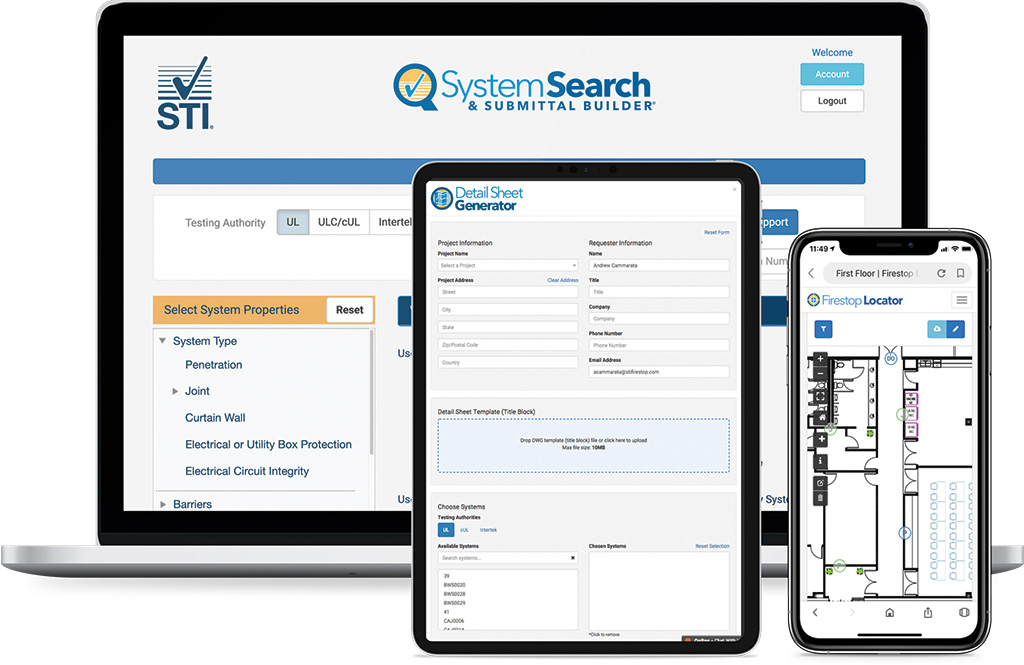
Image courtesy of Specified Technologies Inc.
Software applications can greatly assist with organizing and specifying firestop locations and can be used to communicate design specifications to the entire team before and during construction.
UL systems always display the hourly rating at the top, followed by the wall or floor construction type (e.g., a 1- or 2-hour gypsum wall), and the permitted types of penetrants, which might include steel pipe, cast iron pipe, or conduit. The system will also define the annular space, or the gap between the penetrant and the opening, which must fall within a tested range. Finally, the system will list the required firestop materials—including sealants, wraps, collars, or pillows—to be installed as specified. Deviating from the system, or improvising based on guesswork, compromises both code compliance and life safety.
Choosing the correct UL firestop system depends on a variety of interrelated parameters, each of which must be carefully evaluated to match the specific construction conditions. The goal is not simply to choose a firestop material, but to identify an entire tested system that accounts for the unique variables present at the joint or penetration. At a minimum, this includes identifying the type of assemblies forming the barrier, the joint configuration, the nature of expected movement, and the firestop materials required by the system.
The first consideration is the type of assemblies involved. These may include gypsum board, concrete slabs, concrete masonry units (CMU), or curtain wall systems. The materials and configuration of the adjacent assemblies directly influence the range of suitable UL systems.
Next, the type of joint must be identified. Common joint types include head-of-wall, bottom-of-wall, wall-to-wall, floor-to-wall, floor-to-floor, and curtain wall interfaces. Understanding the location and geometry of the joint is essential because each configuration has different fire dynamics and structural behaviors.
Movement requirements must also be addressed. Joints may be either static or dynamic, with dynamic joints needing to accommodate building movement due to thermal expansion, seismic activity, or structural loading. UL systems designed for dynamic joints will specify the percentage of joint size that the system can safely accommodate without compromising fire resistance.
Finally, material selection is guided by the UL system requirements and the joint conditions. Depending on the situation, a system might require a combination of mineral wool and firestop spray, mineral wool and sealant, sealant-only solutions, or even preformed gasketing products. Special conditions, such as the presence of mechanical or electrical penetrants within a joint, may further narrow the field of acceptable systems.
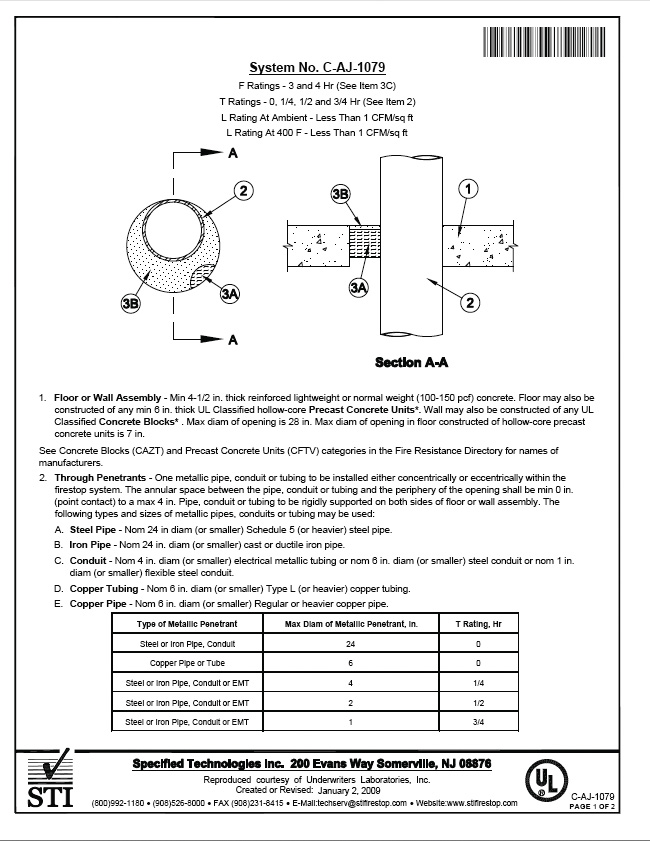
Image courtesy of Specified Technologies Inc.
Data sheets on firestop technologies can be an important tool when designing penetrations in the building. For instance, reference for the T rating is critical in preventing fires that can be ignited by radiant heat alone.
Firestop Special Inspections
The International Building Code (IBC) has long required the proper installation of firestop systems, but as of the 2012 edition, it also mandates special inspections for certain types of buildings. These inspections are not discretionary—they are code-required quality assurance measures intended to verify that installed firestop and joint systems perform as tested. According to IBC 2021 Section 1705.18, special inspections are required for fire-resistant penetrations, joints, and perimeter fire barrier systems in specific building types, including high-rise structures (buildings over 75 feet in height), as well as those classified as Risk Category III and IV.
Risk Category III applies to buildings that pose a substantial hazard to human life in the event of failure, such as schools and large public assembly spaces. Risk Category IV includes essential facilities, such as fire stations, emergency shelters, hospitals, and power plants. In a significant update introduced in the 2021 IBC, special inspection requirements were expanded to include Group R occupancies—primarily residential buildings—when the occupant load exceeds 250 in any fire area. This change reflects growing awareness of the role that properly installed firestop systems play in protecting life safety in densely populated residential environments.
These inspections must occur before firestop systems are concealed, ensuring compliance before finishes are installed. To guide inspectors and building officials, ASTM has published standards that outline the methodology for these evaluations. ASTM E2174 provides the standard practice for on-site inspection of installed firestop systems for penetrations, while ASTM E2393 applies to fire-resistant joint systems. These documents describe the sample sizes, visual criteria, destructive testing allowances, and documentation protocols required to verify compliance.
ASTM E2174 outlines the procedures for field inspection of firestop systems that are used to seal penetrations in fire-resistance-rated construction. It includes requirements for visual inspection, destructive sampling (when approved), inspection frequency, and documentation. E2174 ensures that installed firestopping for penetrants such as pipes, cables, and conduits meets the design intent and performance criteria.
ASTM E2393 provides inspection protocols for fire-resistive joint systems, such as head-of-wall, floor-to-wall, and other construction joints. It establishes a standardized process for verifying correct installation, material use, and continuity of fire protection. The standard helps inspectors confirm that joint systems perform as required under fire exposure.
Although these inspection requirements have been part of the IBC since 2012, enforcement has only recently become more consistent across jurisdictions. In some areas, AHJs have been slow to implement the provisions or lack sufficient resources to carry out inspections rigorously. However, enforcement is increasing as awareness of firestop’s importance grows and as project teams face greater scrutiny from code officials and insurance providers.
By anticipating these inspection requirements during design and clearly documenting firestop systems on construction drawings and in specifications, architects can facilitate compliance and reduce the likelihood of costly project delays. In high-rise, high-risk, or high-occupancy buildings, these inspections are not just a formality—they are critical safeguards that confirm that life safety systems will perform under fire conditions as intended.
COMPLIANCE AND PROTECTION FROM LIABILITY
Meeting firestop requirements isn’t just a matter of code compliance—it’s also a matter of professional liability. One of the most effective ways architects can protect themselves is through well-developed documentation. Specifications and construction documents are not only the foundation for executing a project correctly; they also serve as critical legal records. In the event of a dispute, these documents can be used to verify compliance with code, clarify intent, and demonstrate due diligence.
Construction documents include far more than drawings. They encompass specifications, details, contracts, change orders, certificates, and a host of related materials. This may include Uniform General Conditions (UGCs), owner’s special conditions, submittal logs, and work orders—any of which could be examined during litigation or code review. While firestop specifications may represent only a small portion of the overall documentation package, they play an outsized role in ensuring occupant life safety and mitigating risk to the design team. Relying on outdated boilerplate language or copying details from a past project without review can leave critical gaps and expose the project team to liability.
Attorneys involved in disputes often cannot interpret drawings in technical detail, but they can and will scrutinize written specifications and contractual language. That’s why clarity and specificity in firestop specs are essential—not only to guide proper installation but to support defensible design decisions.
As discussed earlier (but worth repeating), Section 107.2.1 of the IBC states, “Construction documents shall be of sufficient clarity to indicate the location, nature, and extent of the work proposed and show in detail that it will conform to the provisions of this code.” The emphasis here is on the phrase “show in detail.” This reinforces the need to include clear firestop details and notes on drawings—not just generic references—to demonstrate code intent and satisfy the expectations of building officials and AHJs.
Resources for Construction Documentation
The Construction Specifications Institute (CSI) offers a validated framework to help standardize this level of clarity. The CSI three-part format is a widely adopted structure for organizing construction specifications into three distinct parts:
General: This section provides overarching information such as the purpose, scope, quality assurance, and regulatory requirements related to firestopping. It may include details on applicable codes, standards, and responsibilities of various parties involved.
Products: Here, specific products and materials required for firestopping are listed. This includes details such as product names, manufacturers, model numbers, and any applicable performance criteria or certifications. It ensures that the specified materials meet the necessary fire resistance and safety standards.
Execution: This part outlines the procedures and methods for implementing firestopping measures during construction. It covers aspects such as preparation of surfaces, installation techniques, coordination with other trades, and inspection requirements. Proper execution is crucial to ensure the effectiveness of firestopping systems as well as compliance with regulatory requirements.
Following the CSI format ensures consistency, simplifies communication among team members, and improves the enforceability of specifications. It also reinforces the architect’s role in verifying that code requirements are embedded into the design and that the project is built with both performance and liability in mind.
Creating complete, accurate, and easy-to-understand construction documentation is essential not only for code compliance but also for reducing liability and supporting successful project execution. Fortunately, a wide range of resources—both commercial and free—are available to help architects and specifiers develop detailed firestop specifications and drawings.
Among the most widely used tools is MasterSpec, a subscription-based specification platform developed by the American Institute of Architects. MasterSpec offers regularly updated sections on firestopping and recently introduced a new digital interface called SpecPoint. This platform allows users to build project specifications electronically and integrate product-specific content. Many firestop manufacturers, including STI, offer prewritten Basis of Design (BoD) specifications within MasterSpec, providing a convenient starting point for tailored project documentation.
Another widely adopted tool is RIB SpecLink (formerly BSD SpecLink). SpecLink offers a structured, software-based approach where users add content by inclusion—clicking to insert the sections they want to appear in the final document. The system also highlights featured manufacturer products, often with embedded performance data and application guidance. In the SpecLink Cloud interface, for instance, a user selecting fire-rated head-of-wall joints beneath a flat concrete slab simply clicks to activate the relevant section. A blue dot appears next to the item, confirming it will be included in the generated specification set.
In addition to these paid platforms, there are several free online tools that offer a wealth of specification resources, including Arcat, 4Specs, and Sweets. These websites provide downloadable guide specifications, CAD details, BIM objects, and cut-and-paste language from participating manufacturers. It is important to note that these databases are limited to companies that choose to list their products, but they can still serve as valuable starting points for building out your project documentation.
Many firestop manufacturers also maintain robust technical libraries on their websites. These often include editable guide specs, detailed drawings, application guides, installation videos, and software tools for identifying UL systems. These resources are typically free to access, though some may require user registration.
Industry associations also offer technical guidance, educational content, and specification tools. The Construction Specifications Institute (CSI) provides standards for formatting and organizing construction specifications. The American Institute of Architects (AIA) offers firestop education and access to MasterSpec. The International Firestop Council (IFC) and Firestop Contractors International Association (FCIA) both publish best practices, code updates, and installer certification programs. Engaging with these organizations helps architects stay current on evolving code language, specification strategies, and field performance expectations.
Together, these tools and platforms make it easier to specify firestopping accurately, consistently, and in compliance with code, supporting both project success and the architect’s professional responsibility.
Drawing Requirements and Design Judgment
Although firestop systems are not universally required to appear on architectural drawings, many jurisdictions have adopted specific expectations around their inclusion. In California, for instance, agencies such as the State Fire Marshal and HCAI (formerly OSHPD, the oversight body for healthcare facilities) require listed firestop systems to be shown on construction documents. Elsewhere, requirements vary, with some building departments mandating system listings and others leaving the decision to the design team.
Including firestop systems on drawings can be a time-consuming process, particularly given the thousands of available UL listings and the project-specific conditions that must be addressed. However, there are practical approaches that can streamline the process and improve coordination. A common method is to include a firestop system schedule—often in the form of a simple table organized by application type—along with a set of typical firestop details. At minimum, the construction documents should include clear specifications aligned with current codes, standards, and project requirements.
There is no single industry standard for the level of firestop detail required on the drawings. Some design teams choose to include a comprehensive set of firestop systems for penetrations, joints, and perimeter conditions. Others maintain standard partition details but defer mechanical, electrical, and plumbing (MEP) penetrations to engineering consultants or contractors. In some cases, a small number of typical details are provided, while in others, firestop design is treated as a deferred submittal, with contractors responsible for selecting tested systems subject to design team approval.
Ultimately, the decision on how much to include is shaped by project complexity, jurisdictional expectations, and the preferences of the client and design team. Manufacturers often provide ready-to-use details for common conditions, which can reduce the documentation burden while maintaining consistency. While projects with unique conditions—such as high-movement joints or custom curtain wall designs—may require additional coordination, most firestop system needs can be addressed with established manufacturer details and standard listing references.
COMMON MISTAKES WHEN SPECIFYING FIRESTOP
Despite increased awareness of firestopping’s critical role in life safety and code compliance, several recurring specification issues continue to impact project outcomes. These errors often arise from outdated practices, coordination gaps, or missed opportunities for early decision-making. Recognizing these issues in advance can lead to clearer documentation, fewer delays, and improved construction quality.
One of the most frequent missteps is the use of multiple manufacturers’ firestop systems on a single set of drawings. While firestop products may appear interchangeable, UL-listed systems are proprietary and list specific materials by manufacturer. Mixing brands introduces compatibility issues, complicates inspections, and increases the likelihood of RFIs or installation errors. In most cases, a uniform set of details based on a single manufacturer’s systems—identified as the Basis of Design (BoD)—can simplify submittal review, ensure product compatibility, and support more efficient field implementation. This approach is particularly beneficial where joints and penetrations intersect or when space constraints create overlap between systems.
Copying specifications from previous projects is also common. While this may seem efficient, outdated content leads to gaps in code compliance. Building codes evolve, new materials are introduced, and special inspection requirements change over time. For example, newer occupancies may now require special inspection under IBC Section 1705.18, and modern assemblies like mass timber demand specialized systems not addressed in older specifications. Regularly reviewing specifications with a trusted manufacturer representative can help maintain accuracy and alignment with current standards.
A critical coordination issue involves misalignment between firestop specifications and the associated drawing details. This often results in discrepancies between what is shown in Division 07 and the products detailed on the drawings or in MEP sections. Inconsistent documentation may leave intent unclear and complicate enforcement. Best practice is to conduct a specification-to-drawing cross-check during quality control review and direct engineering consultants to refer to the Division 07 firestop section for consistent requirements.
Another commonly overlooked element is the slab edge or curtain wall interface. This building perimeter condition affects both fire and thermal performance and is often missed during early design phases. When not addressed, it may result in the need for Engineering Judgments (EJs), last-minute redesigns, or costly and time-consuming testing. Some jurisdictions prohibit the use of EJs on new construction projects altogether, emphasizing the importance of addressing perimeter fire containment early.
Failure to specify firestop special inspection when required is another significant omission. Projects involving high-rise structures or buildings classified as Risk Category III or IV—including hospitals, schools, and emergency facilities—must include special inspection provisions under the IBC. Incorporating this into the specification is a simple but critical way to align with code and protect both the building owner and design team.
Contractor qualifications are also key. Many specifications now call for certified firestop contractors through programs such as UL’s Qualified Firestop Contractor Program or FM 4991. Despite the value of these certifications, general contractors may be unaware of their availability or concerned about cost and access, particularly in rural areas. Engaging the general contractor early to confirm certification requirements and address sourcing helps ensure they are not overlooked during subcontractor bidding.
Standardizing firestop systems across a project—using one brand wherever feasible—offers additional benefits, including streamlined training, simplified submittals, and reduced risk of product incompatibility. While some public sector clients require multiple options, most private projects can benefit from a single-source approach if coordinated early with the contractor.
Partnering with a company that has a focus on innovation as opposed to the status quo can help architects and designers in achieving a solution set that goes beyond basic code compliance. “The real innovation isn’t just in new products—it’s in helping contractors and facility teams apply firestop correctly in the field,” says Zalepka. “We’re proud to lead the way in training and industry support that protects lives and buildings every day.”
Value-added firestop solutions, such as cable pathway devices, offer significant life cycle benefits but are often eliminated through value engineering if not clearly defined before bidding. These devices reduce future maintenance costs and simplify moves, adds, and changes in data and power systems. If they are not communicated early to the owner and contractor, their benefits may be lost.
Finally, omitting firestop from pre-construction meetings is a missed opportunity. These meetings serve as a critical point of coordination for addressing inspection procedures, material handling, and expectations. Involving the architect, general contractor, subcontractors, AHJ, and firestop manufacturer early helps ensure consistent understanding of system requirements, installation methods, and quality control measures.
CONCLUSION
Firestop systems are an essential yet often misunderstood component of a building’s life safety strategy. From their role in maintaining compartmentation and delaying the spread of fire, smoke, and heat, to their contribution to code compliance and risk mitigation, firestop systems must be addressed with the same level of rigor as any other critical life safety system. Architects play a pivotal role in this process—not only because building codes place firestopping under Division 07, but because clear documentation and thoughtful specification are key to ensuring performance in the field.
Andrew A. Hunt is Vice President of Confluence Communications and specializes in writing, design, and pro-duction of articles and presentations related to sustainable design in the built environment. In addition to in-structional design, writing, and project management, Andrew is an accomplished musician and voice over ac-tor, providing score and narration for both the entertainment and education arena. www.confluencec.com https://www.linkedin.com/in/andrew-a-hunt-91b747/







